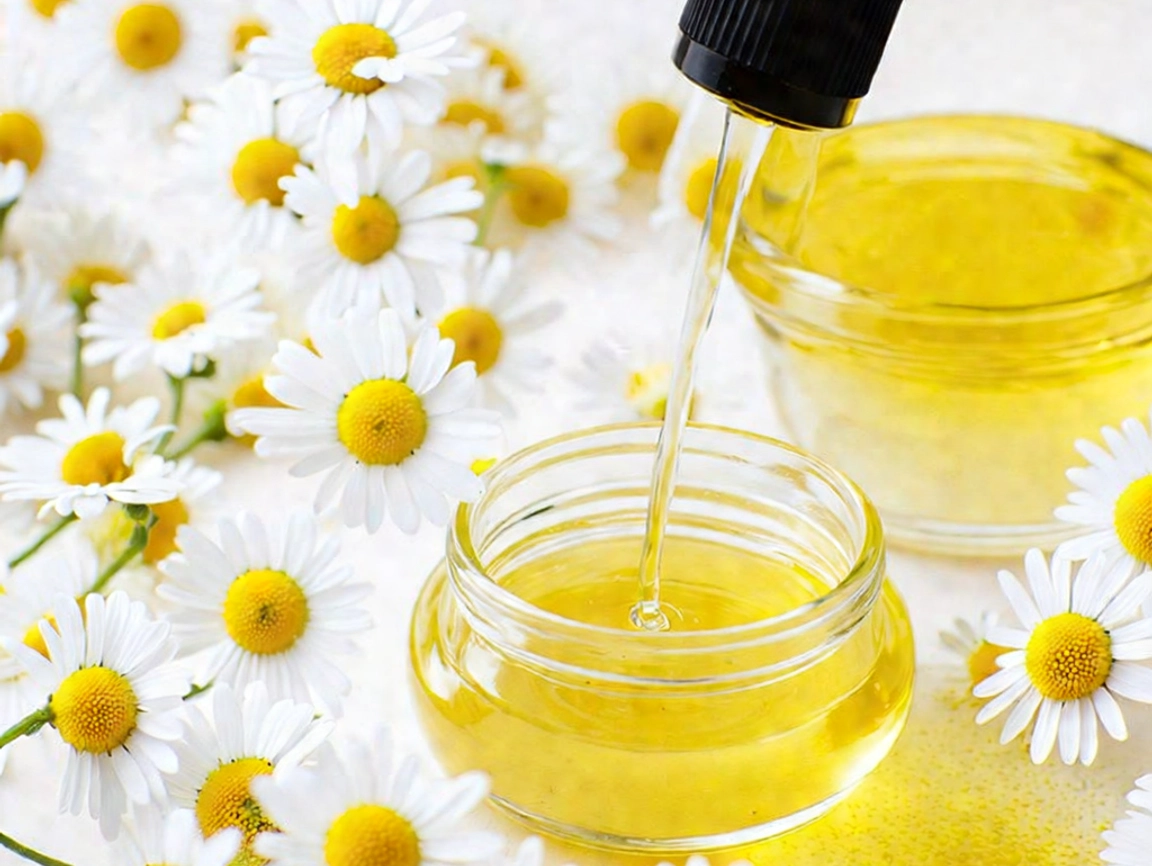I’m a big proponent of using botanical extracts in cosmetic formulations. They can offer genuine benefits and are also fantastic for marketing. Today I’d like to focus on the extract I find myself using most commonly: Chamomile.
Chamomile is known for its gentle and soothing properties. It’s been a staple in both traditional medicine and modern cosmetics for centuries. Extracts derived from chamomile flowers are available in both aqueous (water) and oil forms. You can use them in a wide range of products. I hope to give you a deep understanding of the various benefits.
Chamomile belongs to the Asteraceae family, with Matricaria chamomilla (German chamomile) and Chamaemelum nobile (Roman chamomile) being the most commonly used species in cosmetics. The flowers of these plants are rich in bioactive compounds that can be extracted using different methods to produce either aqueous or oil extracts. Aqueous extraction involves steeping the dried chamomile flowers in water / glycerin / other water-soluble solvents, which allows the water-soluble compounds to infuse into the solution. This method is gentle and it preserves the hydrophilic (water-loving) components of chamomile. These can include compounds called flavonoids, phenolic acids, and polysaccharides. In contrast to this, oil extraction involves infusing chamomile flowers in a carrier oil. This process captures the lipophilic compounds such as bisabolol, chamazulene, and various terpenoids. Oil extracts of chamomile are useful for their anti-inflammatory, antimicrobial, and skin-conditioning properties.
The therapeutic properties of chamomile extracts stem from their rich molecular composition. Aqueous extracts are rich in flavonoids like apigenin, quercetin, and luteolin, which have potent antioxidant properties that protect the skin from oxidative stress and environmental damage. Apigenin in particular has anti-inflammatory activities, making it a valuable ingredient in anti-aging and soothing skincare products. Phenolic acids such as caffeic acid and chlorogenic acid contribute to the extract’s antioxidant and anti-inflammatory properties, helping to neutralize free radicals, reduce skin inflammation, and promote overall skin health. The polysaccharides in chamomile aqueous extract play an important role in moisturizing and soothing the skin by forming a protective barrier on the surface, preventing moisture loss, and enhancing hydration.
Chamomile oil extracts, on the other hand, contain key sesquiterpenes like bisabolol and chamazulene, which have great anti-inflammatory and healing properties. Bisabolol accelerates skin healing and reduces irritation, while chamazulene (which gives the oil its characteristic blue color) offers strong anti-inflammatory effects. Additionally, chamomile oil extracts contain various terpenoids that contribute to their antimicrobial and anti-inflammatory activities. This helps to protect the skin from infections and soothe irritation. Essential oils derived from chamomile, including farnesene and spiroether, have calming and anti-spasmodic properties and are often used in massage oils.
Chamomile extracts can be used widely. Aqueous chamomile extract is an excellent addition to moisturizers due to its hydrating and soothing properties. It helps maintain skin moisture balance and reduces dryness and irritation, making it ideal for hydrating gels, creams, and lotions. The antioxidant-rich flavonoids in chamomile extract help combat signs of aging by neutralizing free radicals and reducing oxidative stress, making it a valuable ingredient in anti-aging creams and serums. Chamomile oil extract, with its anti-inflammatory and healing properties, is perfect for calming serums designed for sensitive and irritated skin, reducing redness, soothing irritation, and promoting skin healing. Facial / shave oils can also benefit. Facial mists containing aqueous chamomile extract provide instant hydration and a calming effect on the skin, making them perfect for refreshing the skin throughout the day.
In haircare, chamomile extracts are included in shampoos and conditioners for their scalp-soothing and hair-brightening properties. The anti-inflammatory effects of bisabolol help to calm an irritated scalp, while the lightening effects of chamomile enhance the natural highlights of the hair, making it look shinier and more vibrant. Scalp treatments formulated with chamomile oil extract help reduce dandruff (although be very careful to avoid making anti-dandruff claims!), soothe itching, and “promote a healthy scalp environment” – a great product claim which is firmly on the side of cosmetics.
Chamomile extracts are also useful for body care products. The moisturizing and soothing properties of chamomile extracts make them perfect for body lotions and creams, helping to hydrate the skin, reduce dryness and irritation, and provide a calming effect. Chamomile extracts are commonly used in after-sun care products due to their anti-inflammatory and healing properties. Nothing is better for sunburned skin than ingredients that soothe, reduce redness and swelling, and promote faster healing. Because they are so gentle, chamomile extracts are safe for use in baby care products. Infant lotions, creams, and shampoos containing chamomile extract help soothe and protect delicate baby skin; this reduces the risk of irritation and diaper rash.
For cosmetic formulators, understanding the unique properties and applications of chamomile extracts can help you to develop inspiring formulations. Whether creating calming serums for sensitive skin, hydrating facial mists, or soothing scalp treatments, chamomile extracts provide a natural and powerful solution for a variety of cosmetic needs. I encourage you to investigate them!

